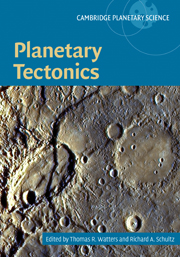Book contents
- Frontmatter
- Contents
- List of contributors
- Preface
- 1 Planetary tectonics: introduction
- 2 The tectonics of Mercury
- 3 Venus tectonics
- 4 Lunar tectonics
- 5 Mars tectonics
- 6 Tectonics of small bodies
- 7 Tectonics of the outer planet satellites
- 8 Planetary structural mapping
- 9 Strength and deformation of planetary lithospheres
- 10 Fault populations
- Index
- Plates
1 - Planetary tectonics: introduction
Published online by Cambridge University Press: 30 March 2010
- Frontmatter
- Contents
- List of contributors
- Preface
- 1 Planetary tectonics: introduction
- 2 The tectonics of Mercury
- 3 Venus tectonics
- 4 Lunar tectonics
- 5 Mars tectonics
- 6 Tectonics of small bodies
- 7 Tectonics of the outer planet satellites
- 8 Planetary structural mapping
- 9 Strength and deformation of planetary lithospheres
- 10 Fault populations
- Index
- Plates
Summary
Summary
The geocentric realm of tectonics changed with the dawn of robotic exploration of the other bodies of the solar system. A diverse assortment of tectonic landforms has been revealed, some familiar and some with no analogues to terrestrial structural features. In this chapter, we briefly introduce some of the major topics in the book. The chapters review what is known about the tectonics on Mercury, Venus, the Moon, Mars, the outer planet satellites, and asteroids. There are also chapters that describe the mapping and analysis of tectonic features and review our understanding of the strength of planetary lithospheres and fault populations.
Introduction
At the most basic level, tectonics concerns how landforms develop from the deformation of crustal materials. The root of the word “tectonics” is the Greek word “tektos,” meaning builder. The building of tectonic landforms is in response to forces that act on solid planetary crusts and lithospheres. Tectonic landforms in turn provide a wealth of information on the physical processes that have acted on the solid-surface planets and satellites.
Until little more than a century ago, the study of tectonics and tectonic landforms was limited to those on the Earth. This changed in the early 1890s when G. K. Gilbert began to study the lunar surface with a telescope. He described sinuous ridges in the lunar maria and interpreted them to be anticlinal folds (see Watters and Johnson, Chapter 4). This marked the beginning of the scientific investigation of tectonic landforms on planetary surfaces.
- Type
- Chapter
- Information
- Planetary Tectonics , pp. 1 - 14Publisher: Cambridge University PressPrint publication year: 2009
- 1
- Cited by



